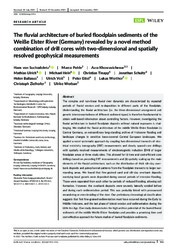The fluvial architecture of buried floodplain sediments of the Weiße Elster River (Germany) revealed by a novel method combination of drill cores with two‐dimensional and spatially resolved geophysical measurements
Pohle, Marco
Khosravichenar, Azra
Tinapp, Christian
Schultz, Jonathan
Ballasus, Helen
Veit, Ulrich
Ettel, Peter
Zielhofer, Christoph
DOI: https://doi.org/10.1002/esp.5296
Persistent URL: http://resolver.sub.uni-goettingen.de/purl?gldocs-11858/9947
Persistent URL: http://resolver.sub.uni-goettingen.de/purl?gldocs-11858/9947
von Suchodoletz, Hans; Pohle, Marco; Khosravichenar, Azra; Ulrich, Mathias; Hein, Michael; Tinapp, Christian; Schultz, Jonathan; Ballasus, Helen; Veit, Ulrich; Ettel, Peter; Werther, Lukas; Zielhofer, Christoph; Werban, Ulrike, 2022: The fluvial architecture of buried floodplain sediments of the Weiße Elster River (Germany) revealed by a novel method combination of drill cores with two‐dimensional and spatially resolved geophysical measurements. In: Earth Surface Processes and Landforms, Band 47, 4: 955 - 976, DOI: 10.1002/esp.5296.
 |
Dokument öffnen: |
The complex and non‐linear fluvial river dynamics are characterized by repeated periods of fluvial erosion and re‐deposition in different parts of the floodplain. Understanding the fluvial architecture (i.e. the three‐dimensional arrangement and genetic interconnectedness of different sediment types) is therefore fundamental to obtain well‐based information about controlling factors. However, investigating the fluvial architecture in buried floodplain deposits without natural exposures is challenging. We studied the fluvial architecture of the middle Weiße Elster floodplain in Central Germany, an extraordinary long‐standing archive of Holocene flooding and landscape changes in sensitive loess‐covered Central European landscapes. We applied a novel systematic approach by coupling two‐dimensional transects of electrical resistivity tomography (ERT) measurements and closely spaced core drillings with spatially resolved measurements of electromagnetic induction (EMI) of larger floodplain areas at three study sites. This allowed for (i) time and cost‐efficient core drillings based on preceding ERT measurements and (ii) spatially scaling up the main elements of the fluvial architecture, such as the distribution of thick silt‐clay overbank deposits and paleochannel patterns from the floodplain transects to larger surrounding areas. We found that fine‐grained sand and silt‐clay overbank deposits overlying basal gravels were deposited during several periods of intensive flooding. Those were separated from each other by periods of reduced flooding, allowing soil formation. However, the overbank deposits were severely laterally eroded before and during each sedimentation period. This was probably linked with pronounced meandering or even braiding of the river. Our preliminary chronological classification suggests that first fine‐grained sedimentation must have occurred during the Early to Middle Holocene, and the last phase of lateral erosion and sedimentation during the Little Ice Age. Our study demonstrates the high archive potential of the buried fluvial sediments of the middle Weiße Elster floodplain and provides a promising time and cost‐effective approach for future studies of buried floodplain sediments. We applied a novel time and cost‐efficient systematic approach to study the architecture of buried floodplain sediments of the Weiße Elster River in Germany by coupling two‐dimensional transects of Electrical Resistivity Measurements and closely spaced core drillings with spatially resolved measurements of Electromagnetic Induction of larger floodplain areas. We found that fine‐grained overbank deposits deposited during several periods of intensive flooding were severely laterally eroded before and during each following sedimentation period probably linked with pronounced meandering or even braiding.
Statistik:
ZugriffsstatistikSammlung:
- Geologie [933]
Schlagworte:
Central Europefloodplain research
fluvial architecture
fluvial geomorphology
geophysical measurements
Little Ice Age
spatial upscaling
This is an open access article under the terms of the Creative Commons Attribution‐NonCommercial License, which permits use, distribution and reproduction in any medium, provided the original work is properly cited and is not used for commercial purposes.

